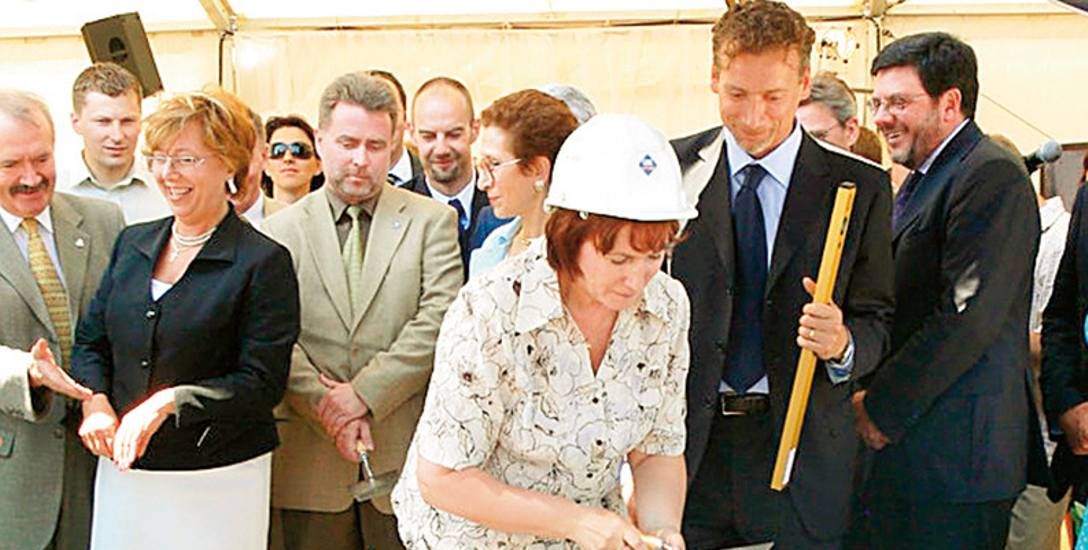 Anna Milczanowska lays the cornerstone for Indesit’s manufacturing plant.
Anna Milczanowska lays the cornerstone for Indesit’s manufacturing plant.
33,000 new jobs, PLN 13 billion worth of investment - these numbers serve to underline the 20 years of history of Lodz Special Economic Zone.
The zone’s importance becomes even clearer when we move a level down and look at specific cities that were given a new lease of life thanks to the zone. This brought them significant economic revival and helped bring down the enormous unemployment rates. It all began in 1997, in times that gave little reason to be optimistic - although, to be fair, those hard times were in fact the driving force behind the creation of the zone. To better understand the nature and importance of the zone, we must go back to the early years after the fall of communism in 1989. The transformation of the economy from a centrally planned system to a market system had many positive results, but also some rather unpleasant side effects. The Polish economy was abruptly cut off from markets east of the border and businesses had to suddenly start operating based on market conditions. While failing companies and entire sectors of the industry lacked any kind of safety cushion, all of the above meant that many regions of Poland experienced an economic and social decline in the early 1990s. Cities and regions reliant on economic monocultures and access to the market in the Soviet Union were particularly affected. Łódź was one such city. Together with other towns in the region, Lodz was badly affected by the crash of its light industry.
Despite objections expressed by some politicians (with regards to state intervention in economic processes,) the special economic zones act was adopted in autumn of 1994. The zones were to become enclaves on the map of Poland. These enclaves were separate areas where preferential administrative, legal and tax terms would apply. The ability to recoup a large part of invested capital through tax reliefs was intended to spark an influx of new investments.
Łodz zone - two years after Mielec
The first zone was created in 1995, in the town of Mielec. The Lodz Special Economic Zone commenced its operations two years later, and not a moment too soon, as the region’s economy was on the brink of another crisis after a brief period of revival due to the collapse of trade with former Soviet Union republics, leading to bankruptcies and rise in unemployment.
In 1997, the Zone encompassed a total area of 204 hectares, divided across four cities: Lodz, Pabianice, Zgierz and Ozorków. Following later expansion, the Zone now comprised 44 sub-zones. Its area has increased several times over and today amounts to 1339 hectares. In the 20 years since its inception, the Zonehas issued more than 300 business licences for new investors. These businesses declared a total of PLN 13 billion in investment expenses, leading to the creation of 33,200 new jobs. The Zone’s importance can be seen all the more clearly by observing its effects on individual towns, , which were able get back on their feet thanks to the Zone. One of these towns is Radomsko.
Success for Radomsko and Kutno
‘The Radomsko Subzone is now one of Zone’s two largest subzones, even though it was created only in 2007’, said Anna Milczanowska, who served as the town’s Mayor between 2006 and 2015. ‘The first project in the subzone was started by Indesit Company. Today, the zone hosts 14 companies, who have created 3700 jobs and invested PLN 1.4 billion. The town’s current unemployment rate of a few percent is impressive, considering that back in 2006 unemployment exceeded 25 percent. Years of hard work and the efforts of many people working to ensure astute development of our Zone finally bore fruit and were one of the factors that significantly contributed to the improvement of Radomsko’s economy. Our business partners have repeatedly stressed that we gave them professional support and quality services. Investors trusted us and we trusted them, and now we’re reaping the benefits. For some time now, companies including Indesit, Whirlpool, Cortizo, Aquila, Union Industries, Hsv and Press Glass have been implementing numerous projects and investments which have begun high-tech manufacturing, leading to the creation of high quality jobs. It was also important to ensure a diversity of capital as a third of companies investing in Radomsko hail from Poland. “I believe that local companies can also take advantage of development opportunities available in the zone, as they are also eligible to benefit from preferential terms” Milczanowska added.
Zbigniew Burzyński, long-serving Mayor of Kutno, is similarly enthusiastic about the Zone. “When the Kutno Subzone of Lodz Special Economic Zone was created in 2001, it became a huge driving force behind the development of our town. At the time, we issued 30 business licences for companies that started their operations in the Kutno subzone. Thanks to this, close to 2500 jobs were created from the ground up in the manufacturing plants located in the Zone and businesses invested more than PLN 2.5 billion. These companies are part of the reason why today we can boast the lowest unemployment rate in the town’s history since the early 1990s. At the end of March 2017, we had 1763 registered jobseekers. This led to a massive improvement of the town’s financial situation. The town’s budget increased threefold since 2001 and the positive thing is that the share of revenues from personal income tax in the budget has been increasing. This means that our citizens are becoming increasingly affluent. Furthermore, the town was able to invest in facilities improving the quality of life of its citizens, such a waterpark or expansion of the local cultural centre” stressed Burzyński.